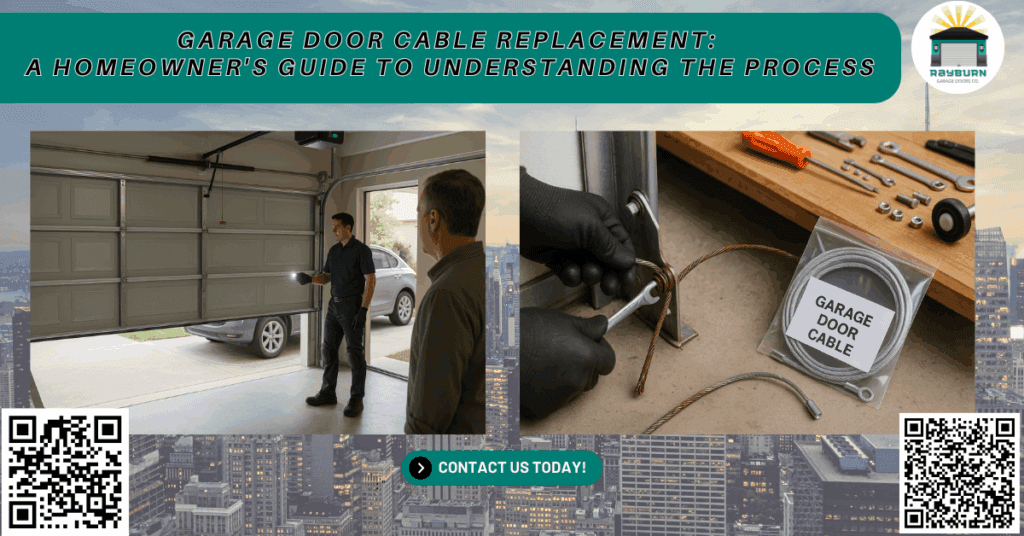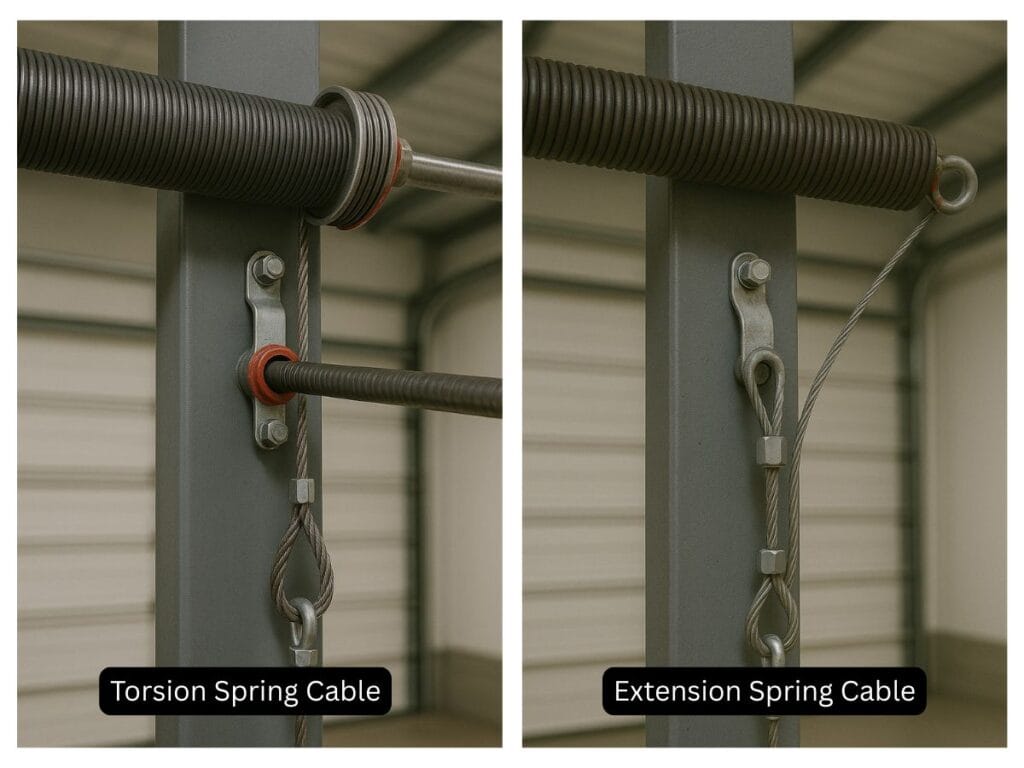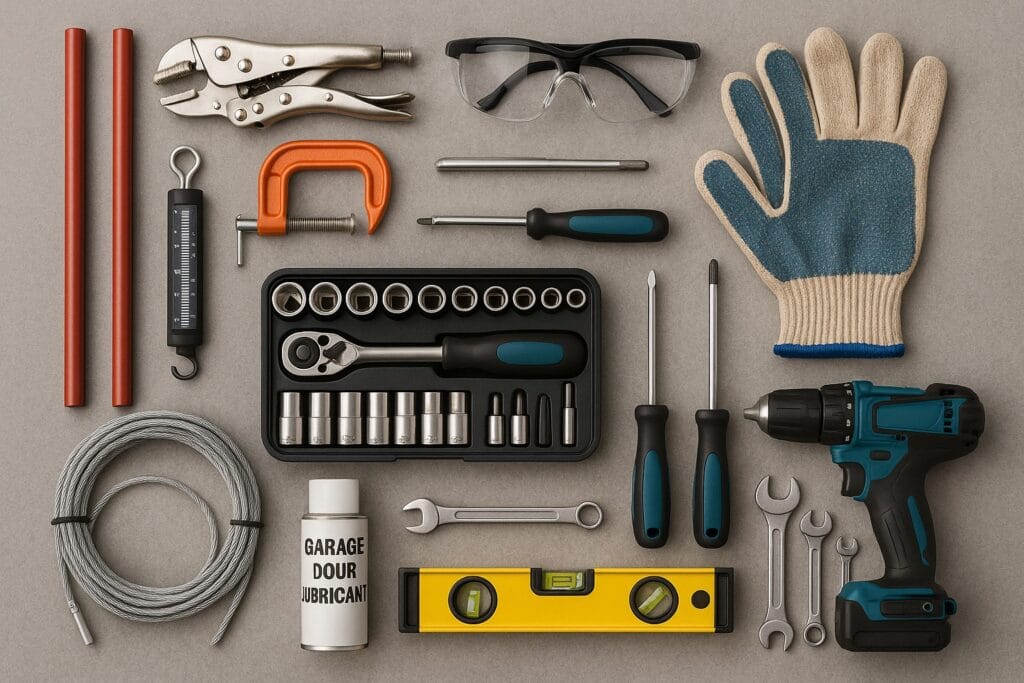Garage Door Cable Replacement: A Homeowner's Guide to Understanding the Process

It was a rainy Thursday afternoon in Plano, TX, when the Callahan family’s routine came to a halt. Their garage door refused to open. A loud snap earlier in the day turned out to be a broken garage door cable. The garage door system, a complex combination of springs, cables, pulleys, and drums, had failed. At Rayburn Garage Doors Co., we responded quickly, identifying the snapped cable and replacing it efficiently, restoring the family’s safety and convenience.
According to the U.S. Consumer Product Safety Commission, garage door-related injuries result in over 20,000 emergency room visits annually. Many of these are tied to problems with garage door cables or springs. Cable replacement may seem minor, but it is vital to the safe operation of your garage door. A frayed or broken cable can render your door inoperable or, worse, cause personal injury or property damage.
If you’re a homeowner wondering whether your door needs attention or just want to be better informed about how your garage door works, this comprehensive guide will walk you through the entire process of garage door cable replacement. You’ll learn how the system functions, what tools and steps are involved in a repair, how to recognize signs of trouble, and why professional garage door service is essential. We’ll also explain preventative maintenance, cost expectations, safety precautions, and what you can do to prolong the life of your garage door system.
What Are Garage Door Cables and Why Are They Important?
Garage door cables are a critical part of the garage door system. They are heavy-duty wires that work together with the garage door springs to lift and lower the door smoothly and safely. Without the proper cables in place, your garage door can become imbalanced, jammed, or even dangerous.
These cables bear the full weight of the garage door and ensure it operates in a controlled and balanced manner. In a system where the garage door weighs between 150 to 400 pounds, cables help reduce strain on the garage door opener and facilitate even lifting. When cables fail, the door can sag, get stuck mid-operation, or fall entirely, presenting serious risks to vehicles, people, and pets.
Types of Garage Door Cables
- Torsion Spring Cables
- These are attached to the bottom brackets on each side of the door and wind around a cable drum as the door opens.
- Torsion spring systems are designed for durability and balance, often found in modern garage doors.
- Extension Spring Cables
- These cables are part of a pulley system and stretch along the track as the door opens.
- They are typically used in older homes or lighter doors and require safety cables to prevent parts from flying if a spring breaks.

Old cables are detached from the bottom bracket aRegardless of the type, each cable must be properly rated for your specific garage door. Using the wrong type can increase wear, lead to failures, or even cause mechanical damage.
Understanding the Garage Door System
Your garage door system is a complex structure consisting of several components that must work in harmony:
- Garage Door Springs (Torsion or Extension): These store energy to assist the door in lifting.
- Cables: Connect the springs to the door and manage lifting/lowering.
- Cable Drum: Grooved wheels that help the cable wrap/unwind neatly.
- Bottom Bracket: The anchor point for cables at the base of the door.
- Torsion Tube: Holds the torsion springs in place and maintains spring tension.
- Garage Door Opener: The motorized component that automates opening and closing.
- Tracks and Rollers: Guide the door as it moves up and down.
Each component plays a role in the reliability and performance of the garage door. For instance, if the torsion springs are incorrectly tensioned, the cables can slacken or tighten unevenly, causing excessive wear. Maintenance of all parts ensures smooth operation and prolongs the life of your system.
Signs Your Garage Door Cables Need Replacement
Garage door cables wear over time due to tension, friction, and exposure to the elements. Here are warning signs that a replacement is needed:
- Frayed or Rusted Cables: Visual damage is the most obvious indicator.
- Uneven Door Movement: One side may raise faster or slower than the other.
- Slack in the Cables: Cables appear loose or hanging.
- Door Jerks or Shakes: Indicates uneven tension or slipping cables.
- Loud Noises or Bangs: Could signify a broken cable or spring.
- Door Doesn’t Stay in Place: If the door doesn’t remain in a halfway position, the cables or springs might be worn.
Other subtle signs include slower operation, scraping sounds, or visible wear on the pulley system or cable drums. Regular inspections can help catch these problems early.
Causes of Cable Damage
Garage door cables can degrade for various reasons:
- Wear and Tear: Constant motion over time leads to fraying.
- Corrosion: Exposure to moisture leads to rust.
- Improper Installation: Misalignment causes uneven wear.
- Lack of Maintenance: Dirt buildup and dryness accelerate deterioration.
- Broken Springs: When a spring snaps, it often causes cables to snap too.
- High Humidity or Temperature Swings: Common in Plano, TX, these conditions promote faster corrosion.
Environmental factors, poor-quality materials, or skipped inspections contribute to early failures. Scheduling preventive maintenance checks can extend the life of your cables and other components.
Risks of DIY Cable Replacement
Replacing garage door cables may seem like a weekend handyman task, but it’s not. Cables are under extreme spring tension. Without proper tools, PPE (personal protective equipment), and expertise, the risk of injury is high.
Common Risks Include:
- Injury from Tensioned Springs: Mishandling can lead to severe injury.
- Door Collapse: A broken or loose cable can cause the door to collapse.
- Property Damage: Missteps can damage your door, opener, or vehicle.
- Voided Warranty: DIY repairs can void manufacturer or service warranties.
You may also misidentify the problem. Sometimes what seems like a cable issue is a problem with the torsion spring or drum. Professionals can assess the full system and address the root cause, not just the symptom.
Step-by-Step Guide to Professional Garage Door Cable Replacement
Step 1: Inspection and Diagnosis
A trained technician will check the entire garage door system. This includes the springs, drums, pulleys, bottom brackets, and opener. Damaged parts are documented and assessed.
Step 2: Secure the Door
To prevent movement, the door is clamped in place, and the opener is disconnected. Safety precautions are observed, including the use of PPE like safety glasses and gloves.
Step 3: Release Spring Tension
For torsion spring systems, the technician will use winding bars to carefully release spring tension before removing the old cables.
Step 4: Remove the Old Cables
nd unwound from the drum. At this point, the technician also checks for further damage or wear.
Step 5: Install the New Cables
New, rust-resistant cables are attached securely to the bottom brackets and threaded onto the cable drums or pulley system, depending on the type.
Step 6: Reapply Spring Tension
Spring tension is carefully reapplied using precise measurements to ensure balance. The torsion tube and setscrews are checked and tightened.
Step 7: Reconnect Opener and Test
The opener is reconnected, and the door is tested multiple times to confirm smooth operation, even balance, and safe function.
Step 8: Final Maintenance and Clean-Up
Technicians will lubricate moving parts, tighten bolts, and provide guidance on upkeep. Preventive maintenance tips are also shared. They may also recommend regular inspection intervals to monitor future wear.
Tools and Equipment Used in Cable Replacement
A professional technician comes equipped with:
- Winding bars
- Locking pliers and clamps
- Safety glasses and gloves
- Socket set and screwdrivers
- Replacement cables
- Tension gauge
- Garage door lubricant
- Drill, level, and wrench set

These tools ensure the task is done safely, efficiently, and correctly the first time. Attempting this job with basic household tools is risky and not recommended.
How Long Does Cable Replacement Take?
The typical garage door cable replacement takes 1 to 2 hours. However, time may vary depending on:
- Door size and weight
- Number of cables replaced
- Condition of related parts (drums, springs, pulleys)
- Type of system (torsion or extension)
- Accessibility of the area and severity of damage
Emergencies or systems with old or corroded parts may take longer due to the need for additional repairs.
Garage Door Cable Replacement Costs
Costs depend on your garage door system and the parts required:
- Standard Cable Replacement: $100 to $200
- Custom Doors or Additional Repairs: $200 to $400+
- Emergency Service: May involve added charges
Rayburn Garage Doors Co. offers upfront pricing and free estimates so you know what to expect. Our goal is to provide affordable, high-quality service without surprise costs.
Maintenance Tips for Garage Door Cables
Extend the life of your garage door system with these upkeep tips:
- Routine Maintenance: Inspect cables, springs, and opener regularly.
- Lubrication: Apply silicone spray to moving parts every 3 to 6 months.
- Visual Inspections: Look for frays, rust, and slack.
- Keep Tracks Clean: Remove debris or buildup along the door tracks.
- Avoid DIY Adjustments: Never tamper with tensioned parts yourself.
- Schedule Annual Service: Prevent costly repairs with professional tune-ups.
- Test Door Balance: Disconnect the opener and lift the door halfway to check if it stays in place.
These simple steps can prevent major problems and extend the life of your garage door system.
Why Choose a Professional Garage Door Service?
At Rayburn Garage Doors Co., we specialize in safe, reliable, and long-lasting garage door repairs. Here’s what sets us apart:
- Experienced Technicians: Skilled in both residential and commercial garage door systems.
- Quick Response Times: Emergency same-day service available.
- Fully Equipped Service Trucks: Tools and parts on hand to complete most jobs immediately.
- Warranty Coverage: Peace of mind for parts and labor.
- Safety First Approach: We follow industry safety protocols.
- Customer-Focused Service: We prioritize your satisfaction and safety above all else.
Professional garage door repair ensures your system stays in top shape for years to come.
Final Thoughts
Garage door cables are often overlooked, yet they are among the most important components in ensuring safe and efficient garage door operation. Knowing the signs of wear, understanding the risks of DIY repairs, and taking proactive maintenance steps can save you money and prevent injuries.
When problems arise, don’t wait. A single frayed or broken cable can disrupt your entire garage door system and lead to further damage. Trust a professional garage door technician to diagnose, repair, and maintain your system with precision and care.
At Rayburn Garage Doors Co., we are committed to keeping your home safe and functional. With years of experience, prompt service, and a dedication to quality, we are Plano’s top choice for garage door cable replacement and repair.
How Can Rayburn Garage Doors Co. Help You?
If you’re in Plano, TX, or the surrounding areas and need help with your garage door, Rayburn Garage Doors Co. is your go-to solution for all things garage door-related. Whether it’s a broken cable, worn springs, or a full garage door replacement, we’re here to help.
- 📍 Address: 4600 TX-121, Plano, TX 75024
- 📞 Phone: (469) 414-3265
Call us today or book online here to schedule your inspection or emergency repair service. We guarantee fast, professional, and courteous service every time. Let us help you restore your garage door to perfect working order.
Frequently Asked Questions (FAQs)
1. Can I manually open my garage door if the cable is broken?
Yes, but it is not recommended due to safety concerns; the door may be unbalanced and extremely heavy, posing a risk of injury.
2. How often should garage door cables be inspected?
Cables should be inspected at least twice a year during regular garage door maintenance or more frequently if you notice signs of wear.
3. Are garage door cables universal or do they vary by door type?
Garage door cables vary by door size, weight, and spring system; using the wrong type can lead to improper operation or damage.
4. What should I do if my garage door cable snaps at night or on the weekend?
Contact a garage door company that offers 24/7 emergency services to secure your home and avoid using the door until it’s repaired.
